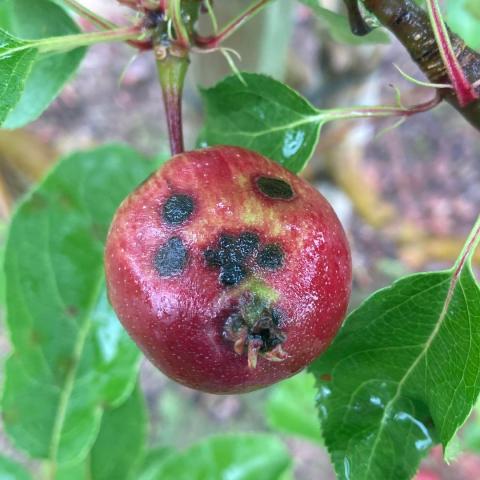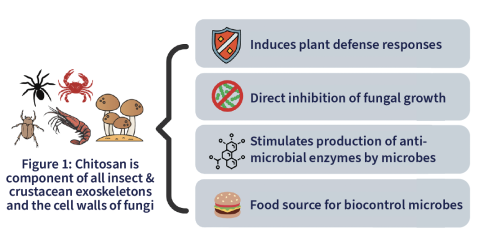Key Findings

Apple trees treated with chitosan and bio-pesticides produced fruit with less severe apple scab symptoms comparable to the standard fungicide program.
When applied after harvest, chitosan reduced the severity of bitter rot and blue mold symptoms on apples.
About the Co-Author

Anissa Poleatewich, assistant professor, Agriculture, Nutrition, and Food Systems; the Poleatewich Plant Pathology at UNH
Contact information: Anissa.Poleatewich@unh.edu, 603-862-0104
This research was published in the INSPIRED: A Publication of the New Hampshire Agricultural Experiment Station (Summer 2022)
Researchers: A. Poleatewich, L. Degenring and K. Peter
Management of tree fruit diseases is especially challenging in the northeastern United States due to ideal climatic conditions for pathogen spread and infection leading to devastating fruit losses. Since the 1980s, research at UNH has been integral in collaborative efforts to develop disease forecasting models and integrated pest management (IPM) strategies that combine cultural, biological and chemical strategies to limit crop loss and reduce pesticide use in fruit trees. Today, UNH scientists continue to build on this legacy. Current research focuses on whether seafood byproducts can provide sustainable, cost-effective disease and pest management for New Hampshire growers battling tree fruit diseases.
Biopesticides
It is critical for growers to have a diverse set of tools in their "toolbox" to manage diseases. One strategy of IPM is to harness the power of beneficial microbes (biopesticides) and natural compounds to promote plant growth and suppress disease. Chitosan is a promising natural compound documented to have antifungal and disease suppressive properties (see Figure 1). Chitosan is one of the most abundant polymers on earth and is an important component of all insect and crustacean exoskeletons. Some companies have begun utilizing waste from the seafood industry as a source of chitosan for use in agriculture crop protection products. The use of chitosan to prevent disease and extend shelf life of perishable fruits has been well documented. Less is known about the potential of preharvest application of chitosan to suppress diseases during the growing season and whether chitosan acts synergistically with standard fungicide or biopesticide spray programs. This research seeks to identify the utility of chitosan as a tool to manage diseases of apple during preharvest and postharvest.
Studying chitosan applications
The research assessed two questions regarding chitosan application:
- Can foliar (liquid spray) applications of chitosan alone or in combination with biopesticides reduce preharvest apple diseases?
- Can chitosan applications reduce postharvest diseases of apple?
For the preharvest study, a commercial chitosan product (Tidal Grow) was evaluated and applied alone or combined with a program of reduced risk materials typical of Northeast orchards. Chitosan treatments were applied according to manufacturer recommendations and compared with a standard fungicide. Throughout the season, leaves and fruit were evaluated for apple scab and powdery mildew and for symptoms of summer fruit rot and rots that might remain dormant but appear later in storage.
Leaves and fruit from trees treated with the reduced risk program and the chitosan resulted in the lowest incidence of apple scab comparable to the fungicide control. While the chitosan treatment alone did not reduce incidence of apple scab, the severity of symptoms was significantly less on fruit treated with chitosan compared with fruit treated with the fungicide control.
Chitosan's postharvest efficacy was assessed on fruit collected from local farms in New Hampshire and dipped in Tidal Grow or in water. Next, fruit was inoculated with two common fruit rot pathogens, Colletotrichum fioriniae (causing bitter rot) and Penicillium expansum (causing blue mold). Results indicate that fruit treated with chitosan had significantly smaller lesions caused by C. fiorniae and P. expansum compared to fruit dipped in water only.
This research suggests that chitosan may have potential as a new tool for growers to use as part of their IPM programs. However, additional research is needed to investigate application rate, application timing and compatibility with other grower practices.
This research was partially supported by the Northeast Sustainable Agriculture Research and Education program under subaward number GNE19-198-33243 and by the U.S. Department of Agriculture's Agricultural Marketing Service. The authors thank the Penn State Fruit Research and Extension Center and a number of New Hampshire farms for space to conduct trials.


